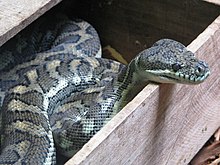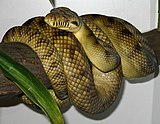Morelia (snake)
Appearance
| Morelia | |
|---|---|

| |
| Morelia spilota | |
| Scientific classification | |
| Kingdom: | |
| Phylum: | |
| Subphylum: | |
| Class: | |
| Order: | |
| Suborder: | |
| Family: | |
| Genus: | Morelia J. E. Gray, 1842
|
| Synonyms | |
Morelia is a genus of large snakes in the Pythonidae family. They are found in Indonesia, New Guinea, and throughout Australia. Currently, 8 species are recognized.[3]
In general, these snakes are arboreal to semi-arboreal, spending much of their life in the forest canopy. Although there are exceptions, most attain adult lengths of 2–3 m (6.6–9.8 ft).
Geographic range
Found from Indonesia in the Maluku Islands, east through New Guinea, including the Bismarck Archipelago and in Australia.[1]
Species
There are seven species recognised at ITIS.[3]
| Species[3] | IUCN Status[4] | Taxon author[3] | Subsp.*[3] | Common name | Geographic range[1] |
|---|---|---|---|---|---|
| M. amethistina | LC[5] | (Schneider, 1801) | 5 | Amethystine python; Scrub python | Indonesia (Maluku Islands, Timorlaut Islands, Banda, Kai Islands, Aru Islands, Misool, Selawati, most of Western New Guinea, many islands in Geelvink Bay), Papua New Guinea (including Umboi Island, Bismarck Archipelago, Trobriand Islands, the d'Entrecasteaux Islands to Rossel Island, Louisiade Archipelago), and Australia (on some islands in the Torres Strait, the northern Cape York Peninsula south including the Atherton Tableland and the eastern foothills of the Great Dividing Range). |
| M. boeleni | (Brongersma, 1953) | 0 | Boelen’s python | Indonesia (Western New Guinea in the Wissel Lakes region) and Papua New Guinea (the provinces of Eastern Highlands, Central and Morobe, and Goodenough Island). | |
| M. bredli | (Gow, 1981) | 0 | Bredl’s python; Centralian python | Australia, in the mountains of southern Northern Territory | |
| M. carinata | (L.A. Smith, 1981) | 0 | Rough scaled python | Australia, northwestern Western Australia in the lower sections of the Mitchell and Hunter rivers, just inland from the coast. | |
| M. oenpelliensis | (Gow, 1977) | 0 | Oenpelli python | Australia, Northern Territory, in the sandstone outcrops of western Arnhem Land. | |
| M. spilotaT | LC[6] LR/nt[7] |
(Lacépède, 1804) | 6 | Carpet python; Diamond python | Indonesia (southern Western New Guinea in Merauke Regency), Papua New Guinea (southern Western Province, the Port Moresby area of Central Province and on Yule Island) and Australia (excluding much of the center and north west of the country). |
M. viridis 
|
LC[8] | (Schlegel, 1872) | 1 | Green tree python | Indonesia (Misool, Salawati, Aru Islands, Schouten Islands, most of Western New Guinea), Papua New Guinea (including nearby islands from sea level to 1,800 m elevation, Normanby Island and the d'Entrecasteaux Islands) and Australia (Queensland along the east coast of the Cape York Peninsula). |
| M. riversleighensis† | (Scanlon, 2001 ) | 0 | n/a | Extinct, remains found in Queensland, Australia. |
*) Not including the nominate subspecies.
T) Type species.[1]
See also
- List of pythonid species and subspecies.
- Pythonidae by common name.
- Pythonidae by taxonomic synonyms.
References
- ^ a b c d McDiarmid RW, Campbell JA, Touré T. (1999). Snake Species of the World: A Taxonomic and Geographic Reference, vol. 1. Herpetologists' League. 511 pp. ISBN 1-893777-00-6 (series). ISBN 1-893777-01-4 (volume).
- ^ Scanlon, J.D. (2001). "Montypythonoides revisited: the Miocene snake Morelia riversleighensis (Smith and Plane, 1985) and the question of pythonine origins". In Hand, S.J.; Laurie, J.R. (eds.). Riversleigh Symposium 1998: Proceedings of a Research Symposium on Fossils from Riversleigh and Murgon, Queensland, held at the University of New South Wales, December, 1998. Memoirs of the Association of Australasian Palaeontologists 25. pp. 1–35.
- ^ a b c d e "Morelia". Integrated Taxonomic Information System. Retrieved 10 September 2007.
- ^ International Union for Conservation of Nature and Natural Resources. "IUCN Red List of Threatened Species".
- ^ Template:IUCN
- ^ Template:IUCN
- ^ Template:IUCN
- ^ Template:IUCN
External links
![]() Media related to Morelia (genus) at Wikimedia Commons
Media related to Morelia (genus) at Wikimedia Commons
![]() Data related to Morelia at Wikispecies
Data related to Morelia at Wikispecies
- Morelia at the Reptarium.cz Reptile Database. Accessed 10 September 2007.




